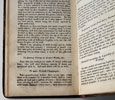Plat - Kt.
Sir Hugh
A very scrace book.
THE JEVVEL HOUSE.
OF Art and Nature: Containing Divers Rare and Profitable Inven-tions, together with sundry new Experiments in the Art of Husbandry. WITH Divers Chymical Conclusions concerning the Art of Distillation, and the rare practices and uses thereof. Faithfully and faniliarly set down, according to the Authors own Experience. (a single top line) By Sir Hugh Plat of Lincolns-Inne, Knight. (a single bottom line) Whereunto is added, A rare and excellent Discours of Minerals, Stones, Gems and Rosins: with the vertues and use thereof, By D. B. Gent. (a single line) LONDON: Printed By Elizabeth Alsop. and are to be sold at her house in Grubstreet, near the Upper Pump. 1653. All enclosed within thick ornate border.
Small quatro. 194 x 153 x 24mm. 3 feps with the small stamp of the Assay Office Library Birmingham. The Title page. 2p A dedication to the Honourable, Boulstroad Whitlock. 4p of The Table. 1-232. 3fep. Some illustrations in text. Title page aged with repairs, with repairs on the verso not effecting text. The next 3 leaves aged. Overall lightly age-browned but clear. Some good repairs has brought the book back to a desirable copy. Bound in quarter brown calf with a darker spine. With raised bands and gilt writing in 3 compartments. The boards covered in strong brown cloth with the tips in calf. Revised edition, expanded from its first appearance in 1594 under the same title, the second overall.
-
Hugh Plat was born in the spring of 1552, and baptised at St. James's, Garlickhythe, on 3 May 1552. He was the third son and eldest surviving of Richard Plat or Platt (1528-1600), a London brewer who ran the Old Swan brewery in James Street, London. His father owned property in St Pancras, London, bequeathing much of it to the foundation and endowment of a free school and six alms-houses at Aldenham, Hertfordshire. He was buried on 28 November 1600. Hugh's mother, Alice, was daughter of John Birtles, of Birtles, Cheshire. Plat matriculated at St John's College, Cambridge, on 12 November 1568 and he graduated with a Bachelor of Arts in 1572. Soon afterwards he became a member of Lincoln's Inn. He resided from 1594 at Bishop's Hall, Bethnal Green, later moving to the neighbouring Kirby's Castle. Both at Bethnal Green and in St Martin's Lane. he maintained gardens, where he conducted horticultural and agricultural experiments. For research, he often visited Sir Thomas Heneage's estate at Copt Hall, Essex, and other large properties. He learned metallurgy from blacksmiths, and worked with gardeners and farmers to gather information on horticulture and agriculture and foodstuffs. In consideration of his services as inventor, Plat was knighted by James I at Greenwich on 22 May 1605. In 1594 there appeared the first edition of 'The Jewell House of Art and Nature, dedicated to Robert Devereux, 2nd Earl of Essex. The volume consists of five tracts with separate title-pages, 1. Divers new Experiments. 2. 'Diverse new Sorts of Soyle not yet brought into any Publique Use. 3. 'Chimical Conclusions concerning the Art of Distillation. 4. 'Of Moulding, Casting Metals. 5.'An offer of certain New Inventions which the Author proposes to Disclose upon reasonable Considerations. This second revised and enlarged edition appeared in 1613, dedicated to Bulstrode Whitelocke, and prepared by 'D. B.' (i.e. Arnold de Boate), who added a sixth tract 'A Discourse on Minerals, Stones, Gums, and Rosins. The Royal Collection Trust has a 1653 copy acquired by Queen Victoria sometime before 1860. The way this text has been printed and published matches Plat's eclectic curiosity and research. Some of the solutions to problems astonish: we are informed on P 19, Turn 5 spits at once with one hand. Then on P 28, How to hold a hot iron bar in your hands without burning. On the next page 29, Sweet cakes made without sugar. Further on P 71, How to keep Oysters good 10-12 days. (without refrigeration. Did this solution create food poisoning in the ignorant.?) Then the same kind of query on P 72, How to keep Lobsters crayfish etc good for some days. Then the fantastical; on P 88, A wagon with illustration. To be drawn by men instead of horses. - Intended to appeal to an audience as diverse as its contents, the book contains advice useful to travellers, farmers, housewives, soldiers, cooks, merchants, apothecaries, builders, distillers, and brewers, or indeed anyone who had “either wit, or will, to apply them.” An interesting book that (ODNB) elevates to Platt's most significant work. It shows to a great extent the need for people to constantly improve their knowledge and circumstance. Making the leap from Plat's time to the present, one wonders if human's will ever find their true comfort-zone, or are we tied to a quest to always follow Plat's example of on-going restless research. ESTC R10675; Goldsmiths' 1294; Kress 889; Wing P2391.






|
|

Antiquarian category
ref number:
11259
|






















































